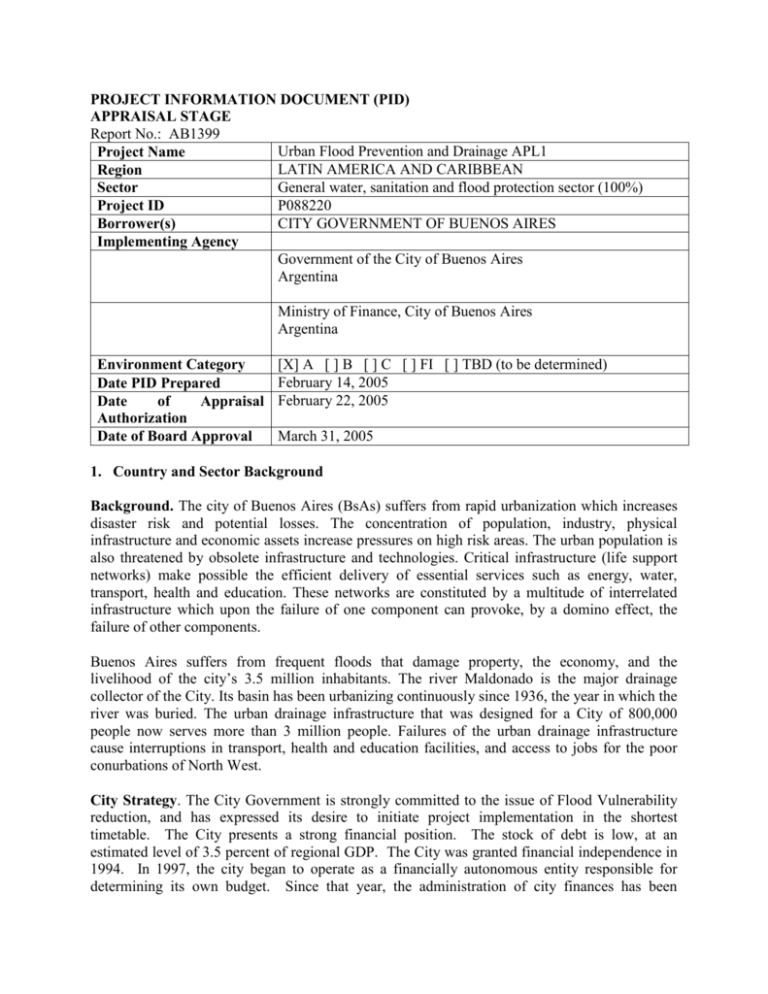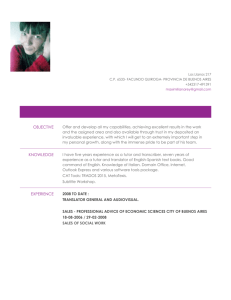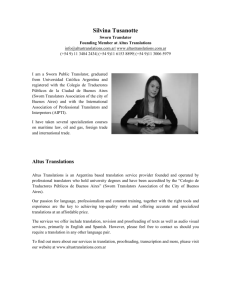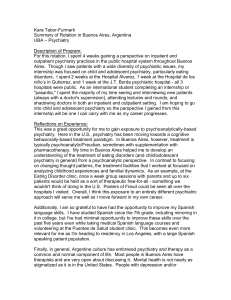Project Name
advertisement

PROJECT INFORMATION DOCUMENT (PID) APPRAISAL STAGE Report No.: AB1399 Urban Flood Prevention and Drainage APL1 Project Name LATIN AMERICA AND CARIBBEAN Region General water, sanitation and flood protection sector (100%) Sector P088220 Project ID CITY GOVERNMENT OF BUENOS AIRES Borrower(s) Implementing Agency Government of the City of Buenos Aires Argentina Ministry of Finance, City of Buenos Aires Argentina Environment Category Date PID Prepared Date of Appraisal Authorization Date of Board Approval [X] A [ ] B [ ] C [ ] FI [ ] TBD (to be determined) February 14, 2005 February 22, 2005 March 31, 2005 1. Country and Sector Background Background. The city of Buenos Aires (BsAs) suffers from rapid urbanization which increases disaster risk and potential losses. The concentration of population, industry, physical infrastructure and economic assets increase pressures on high risk areas. The urban population is also threatened by obsolete infrastructure and technologies. Critical infrastructure (life support networks) make possible the efficient delivery of essential services such as energy, water, transport, health and education. These networks are constituted by a multitude of interrelated infrastructure which upon the failure of one component can provoke, by a domino effect, the failure of other components. Buenos Aires suffers from frequent floods that damage property, the economy, and the livelihood of the city’s 3.5 million inhabitants. The river Maldonado is the major drainage collector of the City. Its basin has been urbanizing continuously since 1936, the year in which the river was buried. The urban drainage infrastructure that was designed for a City of 800,000 people now serves more than 3 million people. Failures of the urban drainage infrastructure cause interruptions in transport, health and education facilities, and access to jobs for the poor conurbations of North West. City Strategy. The City Government is strongly committed to the issue of Flood Vulnerability reduction, and has expressed its desire to initiate project implementation in the shortest timetable. The City presents a strong financial position. The stock of debt is low, at an estimated level of 3.5 percent of regional GDP. The City was granted financial independence in 1994. In 1997, the city began to operate as a financially autonomous entity responsible for determining its own budget. Since that year, the administration of city finances has been prudent. Positive primary surpluses were achieved during 1997-2000 even though the country as a whole went into recession in 1999. To deal with the vulnerability of the urban population and of critical infrastructure, the city risk management strategy will include the following: Risk identification: Hazard maps, vulnerability analysis, understanding the direct, indirect and secondary effects of disasters Risk reduction: natural resource management, land use planning, structural design and construction practices, building codes, early warning systems, and effective disaster preparedness and response plans. strategy, risk transfer and financing, requires an agreement at federal level and will be discussed at a later stage. Choice of instrument and lending modalities. The Bank investment lending support for the proposed program would be through a two phase Adaptable Program Lending (APL). The program would develop a risk management framework to increase economic resilience to flooding with the City of Buenos Aires (phase 1) and provinces subject to flooding (phase 2). The phase 1 of the proposed project would be executed over a period of six years. The City of Buenos Aires would benefit from a direct loan from the Bank with a sovereign guarantee from the Argentinean government. Phase 2 would target the provinces matching trigger indicators and would strengthen the country’s risk management scheme through geographical expansion of sustainable institutions and infrastructure investments. Bank Support. The overall and specific objectives of this project are consistent with the Country Assistance Strategy (CAS) discussed by the Board on April 15, 2004, which seek to reduce the extent and severity of poverty in Argentina by focusing on: (i) sustained economic growth associated with social equity in order to reduce poverty effectively, (ii) greater efforts to foster social inclusion, and (iii) efforts to improve governance with major improvements projected in the efficiency of public administration. 2. Objectives The proposed APL 1 would reduce the City of Buenos Aires vulnerability to flooding through the improvement of the level of protection of its drainage system and the implementation of a risk management program. The project would focus on the issue of risk identification and reduction through prevention, mitigation, and education. To achieve this, the project would increase the city resilience to flooding through: (a) land use planning, building codes, construction practices, urban environment management, increasing information through hazard maps, contingency plans and vulnerability analysis; and (b) the improvement of the city’s flood defenses through water drainage. 3. Rationale for Bank Involvement The Bank can play an important role in assisting Argentina in the development of the infrastructure agenda. Given the relative importance of the economic impact of floods in the Argentine social and economic context, it is anticipated that the results of the program would have significant positive impact on the overall national situation. The Bank has been involved in flood control and prevention in Argentina since 1992. During this period, the 11 Provinces and the City involved with the Bank in the previous projects have developed a strong technical capacity on flood management as well as a strong knowledge of project implementation. The Bank supports the new Government approach because the nature of water management to date has been mainly focused on downstream floods and not on broader multi-sectoral and basin-wide issues. Thus, in application of the new approach of the Acuerdo Federal de Agua, the Bank will proceed with the preparation of an Integrated Water Resource Management program. In parallel, the proposed program can be initiated for the City and specific provinces as far as the selected provinces have previously benefited from basin wide management strategies. 4. Description The proposed project will have three components: Component 1: Risk Management Scheme - € 4.62 M (US$ 6.14 M equivalent) This component would finance actions aimed at providing assistance to the city government to promote a risk management approach in dealing with floods, including prevention, mitigation and response. In addition, the component would strengthen the existing City Agencies so that the transfer of responsibilities from the implementation unit to the agencies would be planned during project implementation. Component 2: Development of Key Defense Facilities - € 91.83 M (US$ 121.8 M equivalent) The structural measures component will finance works for a total of US$ 182 million, including the construction of two collection tunnels of respectively 9.9 km and 4.7 km (US$ 145.7 million), and 46 km of additional secondary connections (US$ 30.9 million) to improve the functioning of the existing draining system in the Maldonado Basin. As stated above, the Maldonado Basin has been considered as the priority area for investment because it comprises 30% of city area and population, and is highly vulnerable to flood recurrence. The tunnels have been designed to complement the existing channel and therefore increase the discharge capacity of the whole system. This component also includes the development of detailed project feasibility studies for the other water basins of the city (Medrano, Vega, South Basins, Ugarteche, White) to prepare the city for future hydraulic investments consistent with the Master Plan. Finally, the component will include contracting a specialized team to supervise tunnel construction, as well as a Technical Panel of Independent Advisors. Component 3: equivalent) Project Implementation and Auditing - € 1.55 M (US$ 2.06 M This component will include the cost of project implementation and annual audits as requested under Bank procedures. The existing project implementation unit (UECBASUPCE) of the city would be the implementing agency of the new project. The implementation unit would progressively transfer project responsibility to city agencies according to their respective capacity, potentially supported by a training plan to be assessed. Those costs include consultant services and functioning expenditures. 5. Financing €m Source: BORROWER INTERNATIONAL DEVELOPMENT BANK FOR RECONSTRUCTION 59 AND 98 ($m equivalent.) 79 130 Total 209 157 6. Implementation The City of Buenos Aires would be the borrower of the proposed Bank loan, with a guarantee provided by the federal government. The Secretary of Finance would be responsible for the execution of the proposed project and, as such, would be the project’s executing agency. The project would be implemented by the implementation unit of the current Flood Protection project, SUPCE under the UECBA, both of which are within the Secretariat of Finance. This unit was created for the ongoing project in 1999 and has supervised the current Flood Protection project, which financed the feasibility study of the proposed project. While it has strong capacity in technical as well as financial project management, such capacity needs to be strengthened in the supervision of tunnel construction, which requires specific expertise. It has thus been decided that UECBA-SUPCE would contract with a specialist firm for the construction period. Regarding the institutional component, UECBASUPCE has been coordinating with the city agencies in charge of the non-structural measures. 7. Sustainability The program and the project address long-term sustainability through: The development of a risk management plan, which will provide the City with strengthened governmental institutions for flood emergencies as well as prevention; Ensuring the implementation of adequate investment strategies and the provision of stable financial resources to ensure continuous maintenance of the defense and drainage works; and The implementation of a comprehensive communication and education program involving NGOs and inhabitants aimed at changing behaviors over the long term. Moreover, sustainability is robustly assured by the strong ownership and commitment of the City Government of Buenos Aires to implement the proposed program and the required institutional and policy frameworks. 8. Lessons Learned from Past Operations in the Country/Sector Due to the Government’s efforts to contain public expenditures in order to achieve economic and fiscal stabilization, resources allocated to infrastructure investment programs are suffering permanent modifications that cannot be anticipated by the executing agencies, and which consequently delay or even stop the progress of project implementation. Given this, and particularly considering the current fiscal situation in the country in general, the proposed program would be proactively monitored throughout project implementation to ensure convergence to a sustainable situation. Too often in the past, flood protection projects in Argentina were designed and implemented without due consideration to the overall maintenance needs of the assets built. Experience has shown the importance of including comprehensive routine maintenance strategies to maintain the overall condition of the infrastructure. The City of Buenos Aires has contracted the maintenance of existing drainage works to the private sector, and committed itself to extend the contract to newly built network and prepare a separate maintenance contract for the tunnels due to their technical specificity. The slow progress of the existing projects, Flood Protection and El Niño, has been due to bureaucratic, non-transparent, and cumbersome procurement procedures. The existing procedures, decided eight years ago in a context of weak provincial institutional capacity, require a systematic clearance of provincial management by the central government. The direct loan to the city will address this issue, the city implementation unit being directly in charge of the project management. 9. Safeguard Policies (including public consultation) Environment. The project has been qualified as “Category A,” given the type of works, unprecedented in Buenos Aires. The most significant environmental issues are associated with the construction management of the two tunnels. Thus, the city carried out a comprehensive EIA report. A full Environmental Management Plan (EMP) has been prepared by the Borrower and approved by the Bank. The results of the study show that most of the planned works will produce - once construction ends - positive effects on the social environment. It is important to highlight that poor people’s livelihood, encompassed by the sphere of influence of the Maldonado Basin, including almost 1,000,000 inhabitants, will be enhanced mainly by vulnerability risk reduction to environmental changes caused by floods. This is partially due to the fact that civil works will significantly improve the current infrastructure. The main potential impacts during the construction period are related to (i) secondary drainage works and construction of wells and derivation chambers during which urban life will be affected by soil excavation, traffic and transport disturbance, noise, dust, and (ii) the evacuation of soil. The management of urban impact during construction will require a comprehensive set of environmental technical specification for construction and strong supervision. Consultation process. In the course of the environmental impact assessment, the city invited environmental NGOs in the framework of the permanent dialogue (Mesa de diálogo ambiental de la Ciudad de Buenos Aires) for a comprehensive presentation of the project. Twenty-one local NGOs were represented and had the opportunity to react and give their comments. They all agreed on the long-term positive impact of the project and accepted the environmental mitigation plan for the construction period. The participants also agreed on pursuing the dialogue with the city during the next phases of the preparation and the implementation. In addition, a public hearing and several focus groups were conducted with potential beneficiaries regarding the project and its impact. Neighbors understood the structural and non-structural aspects of project design and agreed that project impact would be very positive. Given the preventive nature of the project and the fact that the bulk of works will be done underground, they did not envision that project activities will negatively affect their lives. They became aware of the traffic disruptions that are expected due to the construction of secondary drainage systems, but they acknowledged this disruption as a minor cost that would not outweigh project benefits. Regarding the non-structural measures of the project, neighbors made suggestions on how to improve preparedness and coordination in case of floods. The non-structural component of the project will incorporate these suggestions and further develop these arrangements. International Waterways. In accordance with its Policy for Projects on International Waterways (OP/BP 7.50), and at the request of Argentina, the Bank notified Uruguay, the other riparian of the Río de la Plata basin, of the proposed project, and provided the relevant details thereon. Such details confirm that the project will have no adverse effects on the Basin or on Uruguay. The notification letter was sent on January 7, 2005, requesting Uruguay to send the Bank by February 28, 2005, any comments they may have on the project. However, no unfavorable response was received by the Bank by that date. 10. List of Factual Technical Documents Plan Director de Ordenamiento Hidráulico y Control de Inundaciones de la Ciudad de Buenos Aires y Proyecto Ejecutivo para la Cuenca del Arroyo Maldonado, 2004, Halcrow / Harza / Iatasa / Latinoconsult Joint venture; Study of the Regulation of the Alluvial Valley of the Paraná, Paraguay and Uruguay Rivers for Flood Protection, Halcrow, 1994; and Inundacion en el Area metropolitana de Buenos Aires, World Bank, Working Paper, 2001. 11. Contact point Contact: Maryse D. Gautier Title: Sr Urban management specialist. Tel: 1 202 473 75 93 Fax: 1 202 522 3552 Email: Mgautier@worldbank.org 12. For more information contact: The InfoShop The World Bank 1818 H Street, NW Washington, D.C. 20433 Telephone: (202) 458-5454 Fax: (202) 522-1500 Web: http://www.worldbank.org/infoshop





